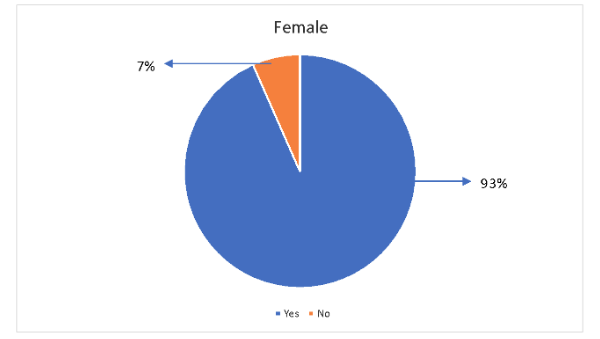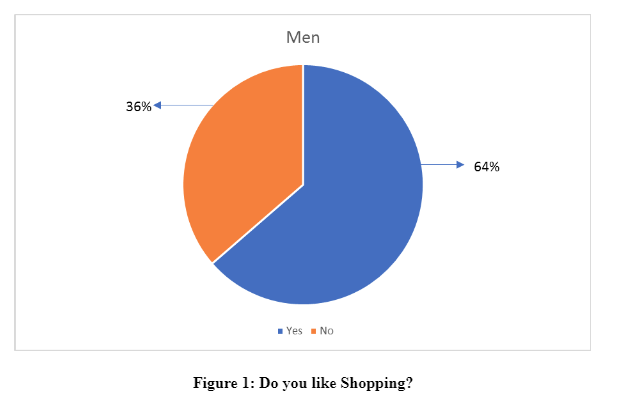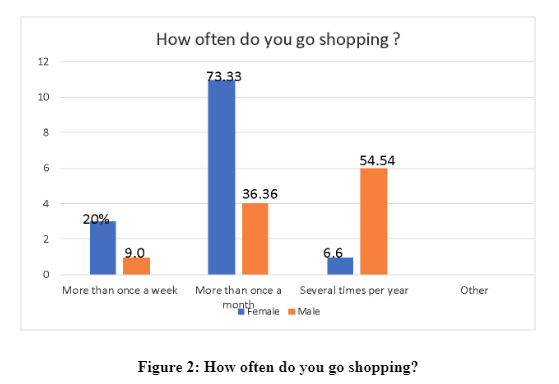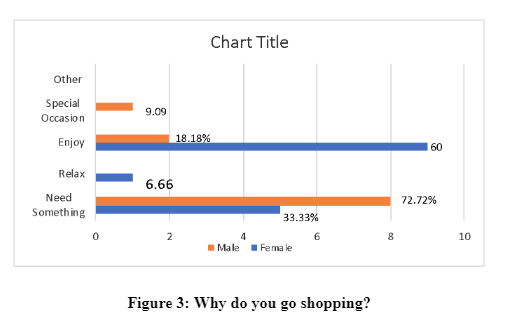1.1 Background Information
Shopping Habit In Between Female and Male
Introduction
Shopping is an action wherein customers search the required goods and services which are presented by retailers to purchase suitable ones among them. People possess needs, and to fulfill them, shopping is done. People shop for food, books, home appliances, etc. as per the requirement of the customers (Bakshi, 2012). However, it is perceived that the habit of shopping in between male shoppers and female shoppers are variant. Male shoppers are the ones who spend lesser time doing the shopping and general approach to the shopping processes to share family responsibility and at the emergence of need (Brosdahl & Carpenter, 2011). On the other hand, female shoppers are found to spend their majority of leisure time shopping for the sake of refreshment and enjoyment. The variation in the shopping habit is found due to various factors, which include interest level, opinions, motives, needs, and activity (Mortimer, 2012). If you need a psychology dissertation help, understanding consumer behavior and shopping habits can provide valuable insights.

Purpose
The purpose of this research is to identify the shopping habits of both males and females. This research will be emphasized the individual behavior of people over shopping and evaluate the difference in shopping habits among males and females. This study will evaluate if females like shopping more than males or not.
1.3 Hypothesis
H1: Female likes shopping more than male
H2: Female doesn’t like shopping more than male
2. Methodology
The research methodology is the technique to identify, select, process and even evaluate the information and data regarding the subject topic.
2.1 Source of data
This study has collected data from both primary and secondary sources wherein a questionnaire survey collects primary data. The students are involved in collecting the data. On the other hand, secondary data are collected through journals, academic papers, and books.
2.2 Methods and instruments of data gathering
There are two types of research methods, namely quantitative and qualitative research methods, wherein this study has applied quantitative methods. Quantitative research was used to attain numerical data, which can apply statistical analysis to validate the hypothesis and to find general answers.
2.3 Description of the procedure
This study has performed a total of 26 surveys, which is done in SurveyMonkey. It is online survey software that assists in creating and running professional online surveys. The closed-ended questions were asked to the students who were then expressed in termed of bar-graphs, pie-charts, etc.
3. Analysis of data
When the participants were asked closed-ended questions regarding shopping, then different views were gathered which are shown below.
3.1 likeliness towards shopping
When the participants were asked that do, they like shopping, than different responses were obtained from both male and female participants. It was observed that 93% of the females said that they like shopping while only 7% refused their liking upon shopping. On the other hand, when male participants were asked regarding their liking towards shopping, then 64% of the male said that they like shopping while the remaining 36% doesn’t show more liking towards shopping.
It is analyzed from this finding achieved that females like more shopping than males.


3.2. Frequency of shopping
When the participants were asked that how often they go shopping, then some of them stated more than once a week while some said more than once a month while some even stated their visits several times per year. It was analyzed from the survey that 20% of the females perform shopping more than once a week, whereas just 9.09% of males were observed on this criterion. Further, 73.33% of the females were seen shopping more than once a month, whereas just 36.36% of males were found in this criterion. Lastly, it was observed that only 6.66% of females were seen shopping several times per year, whereas 54.54% of the males agreed with their purchase yearly. The analysis of this finding has stated that males are least interested in shopping, whereas females are more interested in shopping and perform shopping weekly and monthly.

3.3 Purpose of shopping
When the respondents were asked why to do, they go shopping than various purposes were enlisted. It was seen that the majority of the female's shop to enjoy and when they need something whereas very fewer females were seen doing shopping to relax. On the other hand, it was observed from the male participants than the majority of male go for shopping when they need something, and very fewer people go on a special occasion and to enjoy.

4. Destination
4.1. Conclusion
The study was to analyses the different perceptions of shopping within males and females. It is observed that shopping is an action which is done by people for various purpose. Since it is hypothesized that female-like shopping more than males, the analysis of finding found it to be correct. It was analyzed from the finding analysis that female go on shopping to enjoy, relax and when they need somethings while male go shopping when they need something. This result says that shopping by a male is done on need while females do shop for enjoyment. Thus, it can be stated that the hypothesis which was stated above is correct.
4.2 Recommendation
Since this research has found that female-like shopping more than males, but the survey report didn’t give a clear indication regarding the result. It cannot be said that data assumed is true absolutely, so it is recommended that the researcher would use the interview as a research strategy so that it can get actual results. The results obtained from the interview are more precious as they give major emphasis on the open-ended question, and more time is spend on each participant to attain information.

References
- Bakshi, S., 2012. Impact of Gender on Consumer Purchase Behavior. Journal of Research in Commerce and Management, Vol. No. 1, No. 9, pp. 1-8
- Brosdahl, D. & Carpenter J.M. (2011). Shopping Orientations of US Males: A Generational Cohort Comparison. Journal of Retailing and Consumer Services, Vol. No. 18, pp. 548 –554
- Mortimer, G., 2012. Toward A Shopping Typology of Primary Male Grocery Shoppers. International Journal of Retail & Distribution Management, Vol. No. 10, pp. 790 -810.
- 24/7 Customer Support
- 100% Customer Satisfaction
- No Privacy Violation
- Quick Services
- Subject Experts



